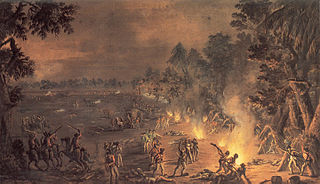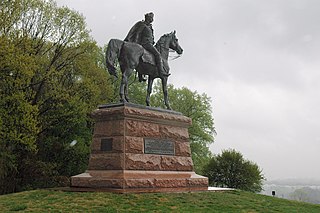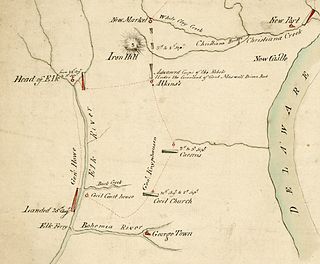
Benjamin Ring House is a historic building on the Brandywine Battlefield in Chadds Ford, Pennsylvania. It served as headquarters for General George Washington prior to and during the September 11, 1777 Battle of Brandywine.

Benjamin Ring House is a historic building on the Brandywine Battlefield in Chadds Ford, Pennsylvania. It served as headquarters for General George Washington prior to and during the September 11, 1777 Battle of Brandywine.

The house was built in 1731 by Thomas G. Clark. [1] Benjamin Ring (died 1804), a farmer and mill operator, was its owner in 1777. As a Quaker, he did not participate in the war. Located along the main road from Philadelphia to Baltimore, the house was about a mile east of the ford at Brandywine Creek.
At the end of August, some 17,000 British troops landed at Elkton, Maryland, and were marching toward Philadelphia. Washington had about 14,600 troops waiting to attack. Washington held a Council of War at the house on September 9, and anticipated that the British Army would cross at the ford. Instead, on September 11, the bulk of British forces crossed upstream and attacked from the north, surprising and overwhelming the Continental soldiers.
The 19-year-old Marquis de Lafayette was wounded in the battle, and carried to the nearby Gideon Gilpin House. [2]
Ring later operated the house as a tavern, and his son operated it as a hotel. Washington had asked Benjamin Ring to lead the Continental army's retreat out of the area when he realized the battle was a loss. Because of his age and weight Ring turned down his request and suggested William Harvey. This was not the William Harvey, Jr. that "defended" the Harvey House on the west bank, but from one of the second generation of Harveys that lived on the east bank. He led the Continental army to safety. This story is from Benjamin Ring's grandson, Samuel, in a letter he wrote to his cousin in the 1830s. Eli Harvey later bought the Ring House and ran a tavern. The Harveys had been maltsters in both England and in Chadds Ford. [3]
A September 16, 1931 fire severely damaged the house. Brandywine Battlefield Park became a Pennsylvania State Park in 1949 and a National Historic Landmark in 1961. The house was restored to its 1777 appearance, and opened as a house museum. [4] A collection of Quaker-style furniture is on display, with historical information about the battle and Washington's stay at the house.

The Battle of Brandywine, also known as the Battle of Brandywine Creek, was fought between the American Continental Army of General George Washington and the British Army of General Sir William Howe on September 11, 1777, as part of the American Revolutionary War (1775–1783). The forces met near Chadds Ford, Pennsylvania. More troops fought at Brandywine than any other battle of the American Revolution. It was also the second longest single-day battle of the war, after the Battle of Monmouth, with continuous fighting for 11 hours.

The Battle of Paoli was a battle in the Philadelphia campaign of the American Revolutionary War fought on September 20, 1777, in the area surrounding present-day Malvern, Pennsylvania. Following the American retreats at the Battle of Brandywine and the Battle of the Clouds, George Washington left a force under Brigadier General Anthony Wayne behind to monitor and harass the British as they prepared to move on the revolutionary capital of Philadelphia. On the evening of September 20, British forces under Major General Charles Grey led a surprise attack on Wayne's encampment near the Paoli Tavern. Although there were relatively few American casualties, claims were made that the British took no prisoners and granted no quarter, and the engagement became known as the "Paoli Massacre."

Brandywine Creek is a tributary of the Christina River in southeastern Pennsylvania and northern Delaware in the United States. The Lower Brandywine is 20.4 miles (32.8 km) long and is a designated Pennsylvania Scenic River with several tributary streams. The East Branch and West Branch of the creek originate within 2 miles (3 km) of each other on the slopes of Welsh Mountain in Honey Brook Township, Pennsylvania, about 20 miles (32 km) northwest of their confluence.

Chadds Ford Township is an affluent township in Delaware County, Pennsylvania. It is located about 25 miles (40 km) southwest of Philadelphia. Prior to 1996, Chadds Ford Township was known as Birmingham Township; the name was changed to allow the township to correspond to both its census-designated place and to distinguish itself from the adjacent Birmingham Township in Chester County. As of the 2010 census, Chadds Ford Township had a population of 3,640, up from 3,170 at the 2000 census.

The Battle of Bound Brook was a surprise attack conducted by British and Hessian forces against a Continental Army outpost at Bound Brook, New Jersey during the American Revolutionary War. The British objective of capturing the entire garrison was not met, although prisoners were taken. The U.S. commander, Major General Benjamin Lincoln, left in great haste, abandoning papers and personal effects.
The 1st Pennsylvania Regiment - originally mustered as the 1st Pennsylvania Rifles; also known as the 1st Continental Line and 1st Continental Regiment, was raised under the command of Colonel William Thompson for service in the Continental Army.
The 2nd North Carolina Regiment was an American infantry unit that was raised for the Continental Army during the American Revolutionary War. In 1776 the regiment helped defend Charleston, South Carolina. Ordered to join George Washington's main army in February 1777, the regiment subsequently fought at Brandywine and Germantown during the Philadelphia Campaign. After most other North Carolina regiments were sent home to recruit, the 1st and 2nd Regiments remained with the main army and fought at Monmouth in June 1778. The regiment was transferred to the Southern Department and was captured by the British army in May 1780 at the Siege of Charleston. Together with the 1st Regiment, the unit was rebuilt and fought capably at Eutaw Springs. The 2nd was furloughed in April 1783 and officially dissolved in November 1783.

The Philadelphia campaign (1777–1778) was a British effort in the American Revolutionary War to gain control of Philadelphia, which was then the seat of the Second Continental Congress. British General William Howe, after failing to draw the Continental Army under General George Washington into a battle in northern New Jersey, embarked his army on transports, and landed them at the northern end of Chesapeake Bay. From there, he advanced northward toward Philadelphia. Washington prepared defenses against Howe's movements at Brandywine Creek, but was flanked and beaten back in the Battle of Brandywine on September 11, 1777. After further skirmishes and maneuvers, Howe entered and occupied Philadelphia. Washington then unsuccessfully attacked one of Howe's garrisons at Germantown before retreating to Valley Forge for the winter.

Pennsylvania was the site of key events and places related to the American Revolution. The state, and especially the city of Philadelphia, played a critical role in the American Revolution.

Willowdale is a small, unincorporated community located in East Marlborough Township, in southern Chester County, Pennsylvania.
The Battle of Matson's Ford was a battle in the Philadelphia campaign of the American Revolutionary War fought on December 11, 1777 in the area surrounding Matson's Ford. In this series of minor skirmish actions, advance patrols of Pennsylvania militia encountered a British foraging expedition and were overrun. The British pushed ahead to Matson's Ford, where units of the Continental Army were making their way across the Schuylkill River. The Americans retreated to the far side, destroying their temporary bridge across the Schuylkill. The British left the area the next day to continue foraging elsewhere; the Continentals crossed the river at Swede's Ford, a few miles upriver from Matson's Ford.
Brandywine Battlefield Historic Site is a National Historical Landmark. The historic park is owned and operated by the Pennsylvania Historical and Museum Commission, on 52 acres (210,000 m2), near Chadds Ford, Delaware County, Pennsylvania in the United States. It is part of the site of the Battle of Brandywine fought on September 11, 1777, during the American Revolution. The Battle of Brandywine covered more than ten square miles, or 35,000 acres. However, the modern park only covers 50 acres which served primarily as the Continental encampment the two days prior to the battle. The battle was a decisive victory for the British and cleared a path directly to the rebel capital of Philadelphia. Brandywine Battlefield Park became a Pennsylvania State Park in 1949 and a National Historic Landmark in 1961.
The Battle of the Clouds was an aborted engagement of the Philadelphia campaign of the American Revolutionary War on September 16, 1777, in the area surrounding present day Malvern, Pennsylvania. After the American defeat at the Battle of Brandywine, the British Army remained encamped near Chadds Ford. When British commander William Howe was informed that the weakened American force was less than ten miles (16 km) away, he decided to press for another decisive victory.

The N. C. Wyeth House and Studio is a historic house museum and artist's studio on Murphy Road in Chadds Ford Township, Pennsylvania, United States. Beginning with its construction in 1911, it served as the principal home and studio of artist N.C. Wyeth (1882-1945). It was restored to its original appearance around the time of his death. The property is managed by the Brandywine River Museum, which offers tours. It was designated a National Historic Landmark District in 1997.

The Battle of Cooch's Bridge, also known as the Battle of Iron Hill, was a battle fought on September 3, 1777, between the Continental Army and American militia and primarily German soldiers serving alongside the British Army during the American Revolutionary War. It was the only significant military action during the war on the soil of Delaware, and it took place about a week before the major Battle of Brandywine. Some traditions claim this as the first battle which saw the U.S. flag.

Kuerner Farm, also known as Ring Farm, is a historic farm in Chadds Ford, Pennsylvania, notable for its association with artist Andrew Wyeth, who created about one-third of his work, over 1,000 paintings and drawings, on subjects he found there over a span of 77 years. The farm was listed in the National Register of Historic Places and declared a National Historic Landmark in 2011. The property abuts the Brandywine Battlefield, another National Historic Landmark. The farm is open to public tours, operated by the Brandywine River Museum.
Philippe Hubert, Chevalier de Preudhomme de Borre joined the French Army in 1740 and served in the War of the Austrian Succession. During the American Revolutionary War he traveled to America where he was presented as a military expert. Promoted to general officer, his career as a Continental Army officer was brief and undistinguished. He resigned under a cloud and returned to France in 1779. His career ended in obscurity.

Thomas Proctor or Thomas Procter commanded the 4th Continental Artillery Regiment during the American Revolutionary War. He was born in County Longford, Ireland, emigrated to British America, married in 1767 in Philadelphia, Pennsylvania and joined the carpenter's guild in 1772. Receiving a commission as an artillery captain in October 1775, he proceeded to raise a company of Pennsylvania state artillery. After a second company was recruited, Proctor was promoted to major and both companies joined George Washington's army. Proctor led his gunners at Princeton in January 1777. The state authorities elevated Proctor to the rank of colonel and charged him to recruit an eight-company Pennsylvania State Artillery Regiment a month later.
Hartley's Additional Continental Regiment was an American infantry unit of the Continental Army that served for two years during the American Revolutionary War. The regiment was authorized in January 1777 and Colonel Thomas Hartley was appointed its commander. The unit comprised eight companies from Pennsylvania, Maryland, and Delaware. When permanent brigades were formed in May 1777, the regiment was transferred to the 1st Pennsylvania Brigade. Hartley's Regiment fought at Brandywine, Paoli, and Germantown in 1777. The unit helped defend the Pennsylvania frontier against Indian raids in the Summer and early Fall of 1778. In January 1779, following a resolution of the Continental Congress the regiment, along with Patton's Additional Continental Regiment and part of Malcolm's Additional Continental Regiment, were combined to form a complete battalion known as the "new" 11th Pennsylvania Regiment. The new 11th participated in the Sullivan Expedition in the summer of that year. In January 1781 the new 11th merged with the 3rd Pennsylvania Regiment and ceased to exist.

Camp Hill is a small unincorporated community that straddles Whitemarsh Township, Upper Dublin Township, and Springfield Township, Montgomery County, Pennsylvania. Located about 3 miles outside Philadelphia, the area played a role in the Revolutionary War.
| Wikimedia Commons has media related to Washington's Headquarters, Brandywine . |
Coordinates: 39°52′27.4″N75°34′46.6″W / 39.874278°N 75.579611°W